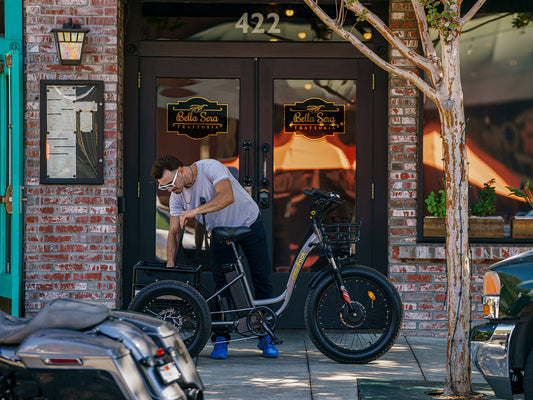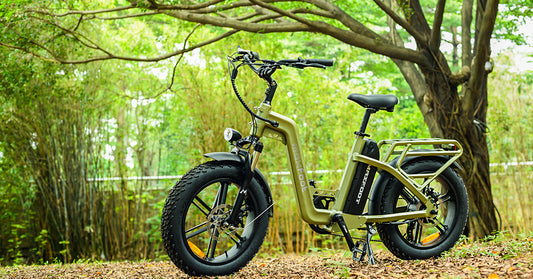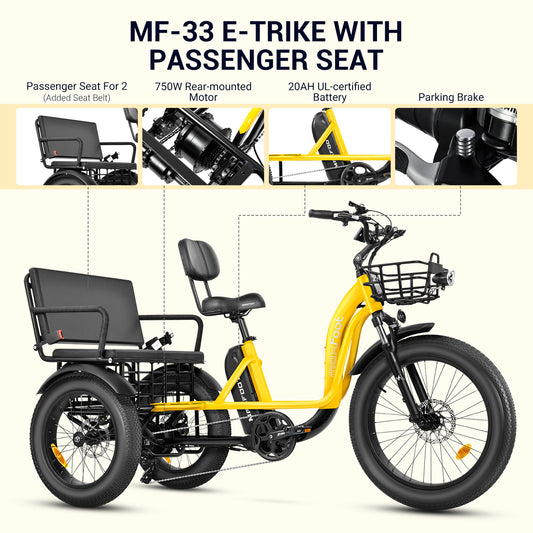As e-mobility becomes more popular, we love to see people change how they experience the world. To make sure that you are purchasing an ebike that meets the safety standards and has the necessary certifications, it is important to do your due diligence before purchasing one. In this way, you can ride with peace of mind, knowing there is only happiness ahead of you.
Here we'll discuss the importance of quality components and materials, battery safety, and other useful information that can prevent ebike battery fires, making sure you ride safely every time on an electric bike.
About Ebike Batteries
An electric bike battery powers the motor of an electric bike by supplying electricity to the battery. There are different types and sizes of batteries, and different types of materials, such as lead-acid, lithium-ion, and nickel-cadmium. Lithium-ion batteries are the most common type of battery used in e-bikes today. This is due to the fact that lithium-ion batteries have a high energy density, which means that it can store a large amount of energy in a small space, and it has a relatively high lifetime. All MaxFoot e-bikes are equipped with lithium-ion batteries.
Capacity of Ebike Batteries
Battery capacity is measured in watt-hours (Wh) or ampere-hours (Ah) and typically ranges from 300 to 1500 Wh. The distance an ebike can ride on a single charge is determined by the capacity of the battery. More power means more range.
UL CERTIFICATION
A great indicator that companies have done their due diligence to ensure that they've used quality materials and rigorously tested their products, UL certification is the industry standard for ensuring product safety. To ensure products meet the fire safety requirements for electric bike batteries, UL conducts extensive tests and inspections, including battery functionality. In December 2022, the Consumer Product Safety Commission sent a letter to 2,000 micromobility manufacturers requiring them to follow this standard*.
The necessary precautions start with the foundation of the product when it comes to e-bike battery safety. Are they built with quality materials? Has it been put through a rigorous testing process to make sure the product is safe to use? Are they certified to prove that this is happening? These are all great questions to ask before you buy, plug in, and jump on.
It's important to consider if the price is appropriate when purchasing an ebike. Cheaper ebikes are typically made with lower quality materials, so be cautious. To determine if a product has been UL certified, search for the UL sticker. Different UL logos can have different meanings, so if you're uncertain, consult public listings for UL certifications or research the various North American UL logos.
Tips for Safe Battery Usage and Handling
It is widely known that ebike batteries can pose a hazard if they are not properly handled, maintained, or constructed with low-quality materials. To ensure e bike battery safety, it is crucial to use only the recommended battery for your ebike and to strictly adhere to the manufacturer's instructions for charging and upkeep.
Here are a few factors to keep in mind to ensure that you have a solid understanding of electric bike fire hazards and prevention:
Battery Charging
When it comes to charging your ebike battery, you have the option of using a standard household outlet or a specialized ebike charger. The amount of time it takes to charge the battery can vary depending on the charger type and the battery capacity, but typically ranges from 2 to 6 hours for a full charge. It's important to avoid overcharging the ebike battery, as this can cause the battery life to degrade and could be dangerous, particularly if the battery is of poor quality.
- To ensure safe charging of your e-bike, it's essential to use the recommended battery and charger. Stick to batteries that are specifically designed and recommended for your e-bike model. When charging, use a charger that has been tested for safety and is specifically designed for the battery. It's also important to ensure that the voltage of the battery charger matches that of the battery itself. If the voltage doesn't match, there's a risk of short circuiting and causing damage to the battery.
- It's crucial to follow the manufacturer's instructions when it comes to charging, maintaining, and using the battery. Take the time to read and carefully follow these instructions to ensure safe and effective operation of your e-bike.
- To prevent potential hazards such as overheating or an electric bike fire, it's important to avoid overcharging the battery. Do not leave the battery charging for extended periods of time, and always disconnect it once it has reached a full charge.
Battery Storing
It's worth noting that the performance and lifespan of an ebike battery can be influenced by various factors, such as how it's used, stored, and maintained. Proper care and maintenance of the battery can contribute to its longevity and optimum performance.
To ensure safe storage of your electric bike battery, there are a few key practices to keep in mind:
-Keep it cool: Avoid exposing the battery to high temperatures, as this can lead to overheating. It's best to store the battery in a cool, dry location and keep it out of reach of children.
-Follow local fire safety regulations: Check with your local fire safety regulations, as they may have specific guidelines for storing e-bike batteries. This will help to ensure that you're adhering to the appropriate safety measures for your area.
To Do & Don't
-Properly dispose of damaged batteries: If a battery is damaged or begins to overheat, handle it with extreme caution and dispose of it properly. Partnering with MaxFoot, Call2Recycle makes battery recycling more accessible and promotes a more sustainable planet. Also, check with your local fire safety regulations, as they may have specific guidelines for e-bike battery disposal and fire safety.
-Regularly check the battery: Check your battery regularly for any signs of damage or wear and tear, such as bulging or leaking. If you notice any such signs, it would be best to replace the battery.
-Never attempt to open or repair the battery: The inside of a battery can be dangerous. If you suspect a problem with the battery, take it to a professional or recycle it.
-Avoid damage: Never puncture or damage the battery, as this can cause a short circuit or even an e-bike fire.
MaxFoot Safety
MaxFoot's ebike batteries and components have received TUV Certification, which means they comply with the UL 2849 standard. This certification involves thorough testing to ensure that the product is safe for public sale and consumer use. To learn more about UL certification and obtain electric bike battery safety tips, check out our blog, "Taking Care Of Your Ebike Battery: The Ultimate Guide." This guide is designed to help protect you, your ebike battery, and those around you.
Ride Free and Safe
Knowledge is a powerful tool and the best protection when it comes to using high-powered products such as ebike batteries and chargers. At MaxFoot, we want to provide you with all the information you need to handle these products with care and ensure your safety and that of those around you. Our riders are of utmost importance to us, and we are dedicated to ensuring their safety both on and off the saddle. We encourage you to spread the word and help us in our efforts to educate and raise awareness about the importance of best practices for ebike batteries and preventing e-bike battery fires. Our goal is to help you continue to find joy in every ride while prioritizing safety.




